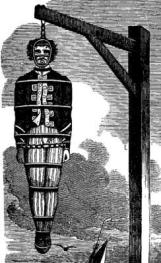Hanging and Gibbeting in chains
In 1611 John Savage and Henry Pennell had an argument near their homes at Tillingham, Essex.
Pennell lost his temper and attacked Savage with a mole spade causing him serious in juries and knocking him to the ground.
Pennell then drew out a knife and cut Savages throat causing fatal injuries.
Pennell was arrested and tried at Essex Assize Court and sentenced to Hanging in Chains.

This was a common practice until the 1800's as it provided long term evidence of justice and deterred other people from committing crime.
Pennell would have been bound with hoops of iron with a loop of iron over his head.
This would have partially encased him and prevented any movement.
Then the hard loop would have been attached to a strong tree or a purpose made structure called a Gibbet or Gallows.
Pennell would then have been hauled into the air above the ground and left to die lingering and painful death.
In this case it is believed that the gibbets were erected on the road to Southminster at Asheldham.
Sometimes the prisoners were executed before they were encased in the metal to give them a more humane death but this was not always the case.
Friends and relatives of Pennell would have been able to visit him while he was still alive and there are records of people feeding the condemned man with milk and other food attached to a stick which they poked in the gaps to keep the man alive for a little longer.
Gibbets were left to hang for at least a year until the person had decomposed leaving little more than a skeleton in the Gibbets.
After about a year relatives were given approval to take the remains down and given a burial.



